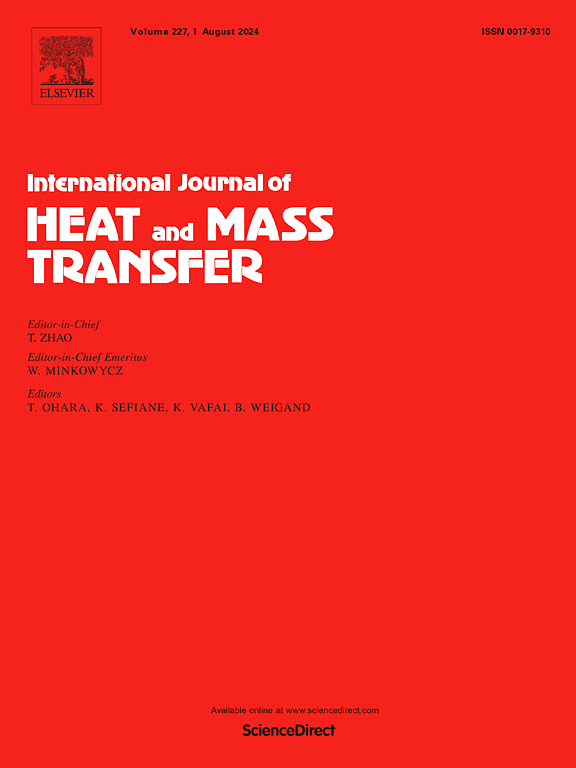Analytical generalized thermal resistance model for conductive heat transfer in pebble beds based on heat flux weighted temperature difference
IF 5
2区 工程技术
Q1 ENGINEERING, MECHANICAL
International Journal of Heat and Mass Transfer
Pub Date : 2024-11-06
DOI:10.1016/j.ijheatmasstransfer.2024.126401
引用次数: 0
Abstract
A novel model for inter-particle contact thermal resistance based on analytical solutions is proposed. By applying the concept of heat flux weighted temperature difference in thermal resistance modeling for the first time, this model offers greater physical significance than traditional thermal resistance models. It effectively describes the dissipation in the heat transfer process and the influence of particle radius on thermal resistance, making it a generalized thermal resistance model suitable for multi-dimensional systems. The impact of applying different levels of uniform heat flux boundary conditions on thermal resistance is analyzed from the perspective of energy dissipation, revealing that a more uniform heat flux input results in lower thermal resistance. The effects of contact radius and particle size on the dimensionless generalized thermal resistance of inter-particle contact were studied, showing that the dimensionless resistance increases with larger particle contact radius and smaller particle size. Using the thermal discrete element method, the thermal resistance model with uniform heat flux density boundary conditions was applied to calculate the effective thermal conductivity of the pebble bed. Considering the distribution of contact radius, differences in effective thermal conductivity at various heights of the pebble bed due to different contact radii were examined and compared with the traditional fixed-coefficient contact resistance model. It was found that the difference between the two models decreases as the contact radius decreases. Finally, multiple sets of fixed contact radii were established under three different particle sizes, revealing that as the contact radius increases, the deviation between the new generalized resistance model and the traditional fixed-coefficient model rises from 8.18 % to 14.64 % for different particle radii.
基于热通量加权温差的卵石床传导传热的广义热阻分析模型
本文提出了一种基于解析解的新型粒子间接触热阻模型。该模型首次在热阻建模中应用了热通量加权温差的概念,与传统的热阻模型相比,具有更大的物理意义。它有效地描述了传热过程中的耗散以及颗粒半径对热阻的影响,是一种适用于多维系统的通用热阻模型。从能量耗散的角度分析了应用不同程度的均匀热通量边界条件对热阻的影响,结果表明,输入的热通量越均匀,热阻越低。研究了接触半径和颗粒尺寸对颗粒间接触的无量纲广义热阻的影响,结果表明无量纲热阻随颗粒接触半径增大和颗粒尺寸减小而增大。采用热离散元法,应用均匀热流密度边界条件的热阻模型计算了卵石床的有效热导率。考虑到接触半径的分布,研究了不同接触半径导致卵石床不同高度处有效导热系数的差异,并与传统的固定系数接触电阻模型进行了比较。结果发现,两种模型之间的差异随着接触半径的减小而减小。最后,在三种不同颗粒尺寸下建立了多组固定接触半径,结果表明,随着接触半径的增大,在不同颗粒半径下,新的广义电阻模型与传统固定系数模型之间的偏差从 8.18 % 增加到 14.64 %。
本文章由计算机程序翻译,如有差异,请以英文原文为准。
求助全文
约1分钟内获得全文
求助全文
来源期刊
CiteScore
10.30
自引率
13.50%
发文量
1319
审稿时长
41 days
期刊介绍:
International Journal of Heat and Mass Transfer is the vehicle for the exchange of basic ideas in heat and mass transfer between research workers and engineers throughout the world. It focuses on both analytical and experimental research, with an emphasis on contributions which increase the basic understanding of transfer processes and their application to engineering problems.
Topics include:
-New methods of measuring and/or correlating transport-property data
-Energy engineering
-Environmental applications of heat and/or mass transfer

 求助内容:
求助内容: 应助结果提醒方式:
应助结果提醒方式:


